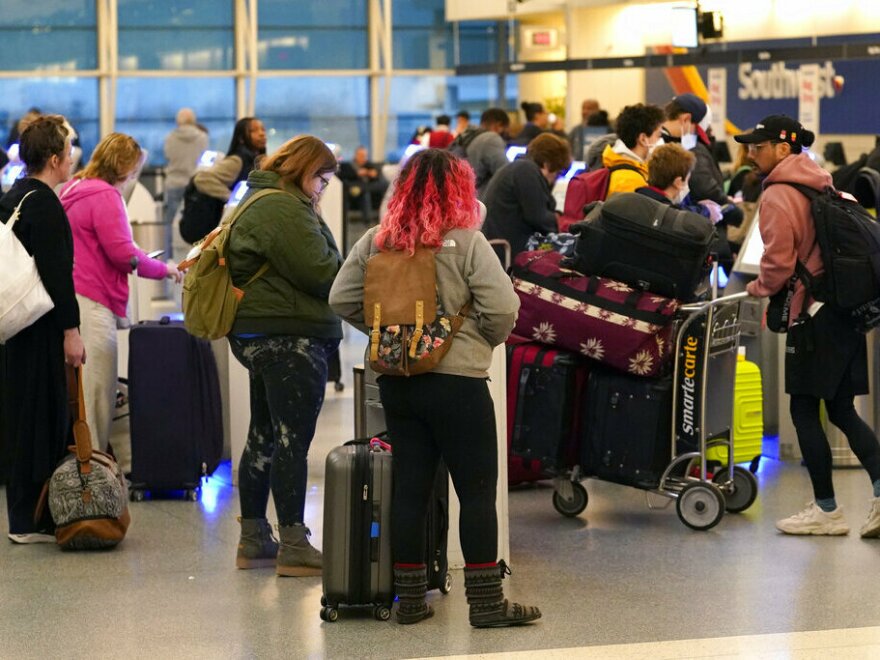CHICAGO — In the wake of a crippling computer system failure this week, aviation industry leaders are calling on Congress and the White House to better support and fund the Federal Aviation Administration's efforts to modernize its outdated technology.
Aviation safety advocates and industry experts say there were warning signs long before Tuesday night's NOTAM system failure that led the FAA to impose about a 90-minute nationwide ground stop of all aircraft departures Wednesday morning, causing thousands of flight delays and cancellations that continued throughout the day.
NOTAMs, or Notices to Air Missions, are messages that alert pilots of potential hazards along their flight routes from the time they push back from the gate until they arrive at their destination.
"A NOTAM is is essentially a little message to a pilot to say, 'Hey, something is different about your flight today that you need to know about it,' " says Mark Zee, a former commercial airline pilot and air traffic controller who now lives in New Zealand.
He says the alerts can be significant, telling pilots that a certain taxiway or runway is closed or that a portion of airspace is closed due to military aircraft exercises. But he says NOTAMs can be rather mundane, such as there might be a mowing crew on the airport grounds, fireworks displays along their route, or that an unimportant light is out.
And Zee says the sheer volume of messages is overwhelming, especially when flying transcontinental or overseas routes, because the longer the flight, the more NOTAMs the flight crew will receive.
"For a long-haul flight, say a 10-hour flight, which might be, you know, Paris to Bangkok, you're going to get 1200 of these messages. And the problem is that in those 1200, only one or two or three will be quite critical. You really need to know these ones. But the remaining 1,197 are just not really relevant at all."
Adding to the problem is how the NOTAMs are presented — in all caps, with a lot of abbreviations and acronyms in a way that can look like confusing gibberish to the untrained eye.
"It's a mess," says Zee. "That's a great word to describe it. It's a mess. It's a giant mess," adding that it's "a broken, archaic briefing system from the 1920s, and as a result, they regularly miss critical flight information."
Zee heads an international organization called OpsGroup, whose members include airlines, pilots, air traffic controllers and other aviation stakeholders. The group is working with aviation authorities globally to reform the NOTAM system.
But the problems he is illuminating existed long before, and really have nothing to do with this week's technology infrastructure failure of the FAA's system for delivering NOTAMs.
The FAA has been working to upgrade the computer system for years "to improve the delivery of safety critical information to aviation stakeholders."
The Department of Transportation called the system "failing vintage hardware" in last year's budget request, when the agency asked for $29 million for a program that would accelerate its replacement.
It's just one example of how the agency has struggled to obtain adequate, stable and consistent funding for critical technology upgrades from those who hold the purse strings in Washington, according to many industry stakeholders.
"I think it's very clear that there has to be a call to action amongst our political leaders, Congress and the White House, to fund and properly provide the FAA the resources they need to do the job," Delta Air Lines CEO Ed Bastian said Friday on a conference call with reporters and analysts announcing the company's 4th quarter and year-end financial results.
"I think this is a crystal clear example of the challenge the FAA has faced, when you have aging systems that aren't as resilient as they need to be, you have tools and technologies that are somewhat outdated and you have staffing levels not where they need to be," Bastian said.
Bastian added that modernizing the nation's air traffic control system and other FAA technologies is critical to the safety of the aviation industry and its ability to meet expected growth.
"The FAA, I know, is doing the very best they can with what they have, but we need to stand behind the FAA," Bastian said. "We need to take them off the year-by-year funding that it seems like they go through that's quite often political negotiations, and realize the importance of having a strong aviation infrastructure."
Meanwhile, a group of 120 members of Congress are demanding answers from Transportation Secretary Pete Buttigieg and the FAA about the system fiasco.
The lawmakers, led by new House Transportation Committee chairman Sam Graves, a Republican from Missouri, and Democrat Rick Larsen of Washington, the committee's minority leader, call the computer outage that forced the cancelation of more than 1,300 flights Wednesday, and delayed nearly 11,000 more, "completely unacceptable." They want Buttigieg and FAA officials to explain what caused the computer failure and what steps are being taken to prevent it from happening again.
Copyright 2023 NPR. To see more, visit https://www.npr.org.




